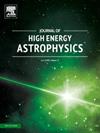Observational analysis of gravitational baryogenesis constraints in Einstein-Æther gravity
IF 10.2
4区 物理与天体物理
Q1 ASTRONOMY & ASTROPHYSICS
引用次数: 0
Abstract
In this article, we investigate the mystery of matter dominance over antimatter through gravitational baryogenesis in context of Einstein-Æther gravity. This study aims to focus on the phenomenon of baryon asymmetry produced in the universe a while after the Big Bang. The supremacy of matter over antimatter is quantified by where s is entropy of the universe and is number of baryon (anti baryon). We take four different models from Einstein-Æther gravity to analyze the ratio and compared our outcomes with the observational bounds. We found this ratio is consistent with the observational data. For a further verification, we examine the Hubble parameter (H) for each model and compared them with observational values, finding a high degree of agreement. Additionally, we perform Chi-square () test on Hubble parameter for each model to assess their compatibility with recent observational data. Furthermore, we compared our findings with the ΛCDM model and the latest Pantheon+SH0ES observational data. This comparison unveiled a reasonable level of consistency among the considered models and the observational data.

爱因斯坦重力重子发生约束的观测分析-Æther重力
在这篇文章中,我们通过爱因斯坦-Æther重力背景下的重力重子生成研究了物质支配反物质的奥秘。这项研究的目的是关注大爆炸后一段时间内宇宙中产生的重子不对称现象。物质对反物质的优势可以用ηBs=ηB - ηB¯s来量化,其中s是宇宙的熵,而ηB(ηB¯)是重子(反重子)的数量。我们采用四种不同的爱因斯坦-Æther引力模型来分析η - b比率,并将我们的结果与观测界进行比较。我们发现这个比值与观测数据是一致的。为了进一步验证,我们检查了每个模型的哈勃参数(H),并将它们与观测值进行了比较,发现高度一致。此外,我们对每个模型的哈勃参数进行χ2检验,以评估其与近期观测数据的兼容性。此外,我们将我们的发现与ΛCDM模型和最新的Pantheon+SH0ES观测数据进行了比较。这种比较揭示了所考虑的模型和观测数据之间的合理的一致性。
本文章由计算机程序翻译,如有差异,请以英文原文为准。
求助全文
约1分钟内获得全文
求助全文
来源期刊

Journal of High Energy Astrophysics
Earth and Planetary Sciences-Space and Planetary Science
CiteScore
9.70
自引率
5.30%
发文量
38
审稿时长
65 days
期刊介绍:
The journal welcomes manuscripts on theoretical models, simulations, and observations of highly energetic astrophysical objects both in our Galaxy and beyond. Among those, black holes at all scales, neutron stars, pulsars and their nebula, binaries, novae and supernovae, their remnants, active galaxies, and clusters are just a few examples. The journal will consider research across the whole electromagnetic spectrum, as well as research using various messengers, such as gravitational waves or neutrinos. Effects of high-energy phenomena on cosmology and star-formation, results from dedicated surveys expanding the knowledge of extreme environments, and astrophysical implications of dark matter are also welcomed topics.
 求助内容:
求助内容: 应助结果提醒方式:
应助结果提醒方式:


